CT is set for a vital role in cardiology
Mark Nicholls reports
Computed tomography (CT) is emerging as an imaging modality set to play an important role in cardiac intervention or surgery. Not only can it be used to plan complex revascularisation procedures and assess the outcome for the patient, but also might help to identify the more dangerous lesions -- so-called ‘culprits’ -- in the future.

At the ECR this year, during a discussion on the role of CT and MRI before cardiac interventions, Professor Christian Loewe (Radiology Department, Medical University Vienna) will examine whether CT can predict the outcome of percutaneous interventions, and during the same session, Dr Marco Francone (University of Rome) will examine whether MRI can predict the outcome of coronary revascularisation.
Professor Christian Loewe acknowledges that MR can be used to select the right patient for revascularisation because it ‘remains the gold standard to identify ischemia and viable myocardium.’ However, the newest CT studies using stress adenosine and late enhancement imaging have demonstrated the potential of CT to provide information on myocardial structure and function in addition to coronary morphology.
Some interventions, he said, can be planned and the outcome predicted by using CT. ‘In cases of chronic total occlusions (CTO) of coronary arteries, CT can directly measure the length of the stenosis, can demonstrate the direction as well as the calcification and can visualise the distal target artery. This information cannot be provided in comparable quality by coronary angiography. In this regard CT can predict, with high accuracy, if an endovascular revascularisation of the CTO will be technically possible or not.’
In recent years, another area of discussion in the cardiology community has been over how many stenoses should be treated. Bypass graft surgery, Prof. Loewe said, always aimed to provide a ‘complete’ revascularisation of the entire heart, thus it was the case that every stenosis seen during coronary angiography was treated, though studies have now shown that for the long-term morbidity of a patient, not all stenoses have to be treated by stent placement. ‘As some stenoses are of high risk for plaque rupture and subsequent myocardial infarction, it would be of great interest to be able to identify the most dangerous ‘culprit’ lesion plaque in advance and to treat them by stent placement,’ he pointed out.
‘Recent CT studies demonstrate that certain features of atherosclerotic plaque indicate an increased risk of those lesions for rupture. While results are preliminary, these data suggest that CT could be used in the future to increase prediction of major coronary events (MACE) but also to tailor intervention strategies.’
During the ECR session, Professor Loewe will demonstrate the possibilities of cardiac CT in assessing myocardial viability for optimised planning of revascularisation and highlight how CT is the only method currently available that provides both morphological as well as functional information.
Dr Francone’s focus will be on the role and importance of cardiac MR as a prognostic predictor of coronary revascularisation. ‘The combination in a single examination of function, stress-perfusion and tissue characterisation with T-2-weighted ‘oedema-sensitive’ and late-gadolinium enhancement (LGE) techniques make cardiac MR (CMR) an almost unique technique in this specific clinical setting.’
While the role of CT is mostly ‘anatomic’, he said the ‘target’ of MR is the myocardium and specifically the unique possibility to combine a functional and morphological assessment due to the well known strengths of the technique like high temporal resolution, greater blood-myocardial image contrast, multi-parametric functional evaluation and availability of various techniques for tissue characterisation.
‘The direct clinical benefit of cardiac MR prior to revascularisation for cardiologists would be to have new indicators to predict patient’s prognosis and revascularisation outcome with better stratification of individual risk and optimisation of therapeutic approach (i.e. stenting vs. CABG vs. medical treatment),’ he said. ‘Patients would obviously avoid unnecessary procedures and the risk of over-treatment. Additionally, use of MR compared to nuclear medicine or MDCT exams would also avoid ionising radiation exposure for the same patient.’
Also during the ECR session, Dr Rodrigo Salgado (Department of Radiology, Antwerp University Hospital) will look at the value of CT before percutaneous aortic valve replacement.
6 March. 4-5.30pm.
The cardiac refresher course: MRI and CT before cardiac interventions or surgery
02.03.2011











